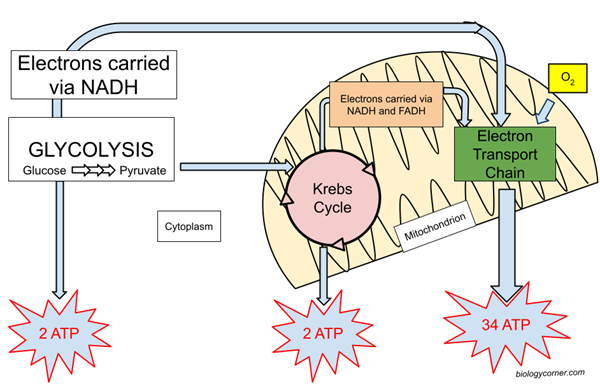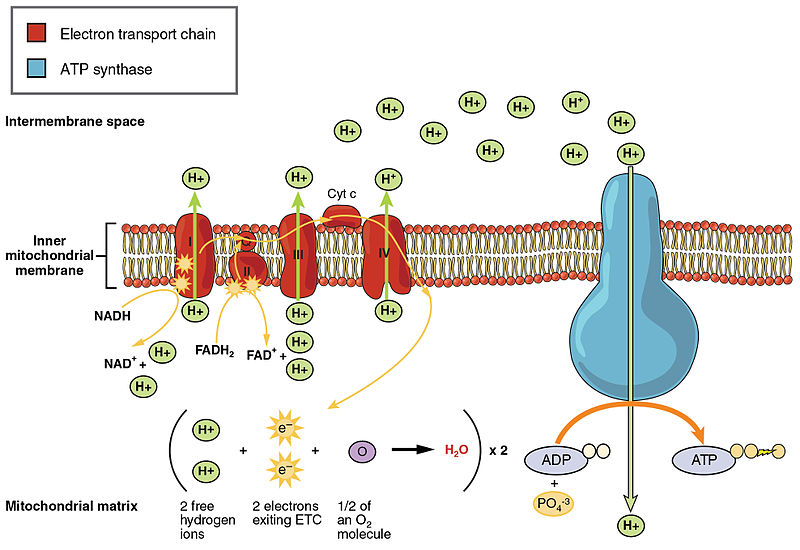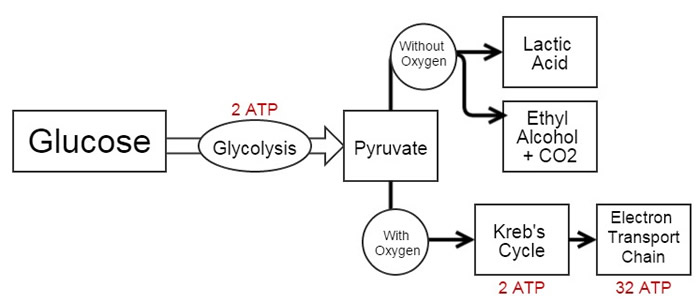Aerobic and Anaerobic Cellular Respiration
Google Slides - overview of the processes with option to print and have students fill in blanks and label diagrams
Aerobic Respiration:
-
Oxygen Requirement: Requires oxygen.
-
Location: Takes place in the mitochondria of eukaryotic cells.
-
Stages:
- Glycolysis: Takes place in the cytoplasm, breaking down glucose into pyruvate.
- Citric Acid Cycle (Krebs Cycle): Pyruvate is further broken down in the mitochondria, generating NADH and FADH2.
- Electron Transport Chain and Oxidative Phosphorylation: Electrons from NADH and FADH2 are used to generate ATP in the presence of oxygen. Water is produced as a byproduct.
- Energy Yield: Aerobic respiration is highly efficient and produces a large amount of ATP (36-38 ATP molecules per glucose molecule).
Anaerobic Respiration:
-
Oxygen Requirement: Does not require oxygen.
-
Location: Can occur in the cytoplasm of both prokaryotic and eukaryotic cells.
-
Stages:
- Glycolysis: Similar to aerobic respiration, glycolysis breaks down glucose into pyruvate in the cytoplasm.
- Fermentation: In the absence of oxygen, pyruvate is converted into either lactic acid (in animals) or ethanol and carbon dioxide (in yeast and some bacteria). This step regenerates NAD+ to keep glycolysis running.
- Energy Yield: Anaerobic respiration is less efficient than aerobic respiration and produces a smaller amount of ATP (2 ATP molecules per glucose molecule in fermentation).
The General Equation for Cellular Respiration is:
C6H12O6 + 6O2 -->6 CO2 + 6H2O + 36 ATP
glucose + oxygen --> carbon dioxide + water + ATP
Cellular Respiration Steps

-
Glycolysis:
- Glycolysis is the first step of cellular respiration and takes place in the cytoplasm of the cell.
- During glycolysis, one molecule of glucose (a six-carbon sugar) is broken down into two molecules of pyruvate (a three-carbon compound).
- This process generates a small amount of ATP and NADH (nicotinamide adenine dinucleotide, a coenzyme).
- Citric Acid Cycle (Krebs Cycle):
- If oxygen is available, the pyruvate produced during glycolysis is transported into the mitochondria for further breakdown in the citric acid cycle.
- Each pyruvate is decarboxylated (loses a carbon dioxide molecule) and combines with coenzyme A to form acetyl coenzyme A (acetyl-CoA).
- Acetyl-CoA enters the citric acid cycle, where it undergoes a series of reactions, ultimately producing NADH, FADH2 (flavin adenine dinucleotide), and ATP.
- Oxidative Phosphorylation:
(Electron Transport Chain)
- The majority of ATP is generated in the third stage through oxidative phosphorylation.
- NADH and FADH2, produced in glycolysis and the citric acid cycle, donate electrons to the electron transport chain (located in the inner mitochondrial membrane).
- As electrons move through the electron transport chain, they release energy, which is used to actively pump protons (H+ ions) across the inner mitochondrial membrane, creating a proton gradient.
- The flow of protons back into the mitochondrial matrix through ATP synthase drives the production of ATP. This process is called chemiosmosis.
Electron Transport Chain (Chemiosmosis)

Anaerobic Respiration - without oxygen
Anaerobic respiration is a process of cellular respiration that occurs in the absence of oxygen. It allows cells to generate energy from glucose or other organic molecules without relying on oxygen as the final electron acceptor. Anaerobic respiration is less efficient than aerobic respiration in terms of ATP production and typically involves a step called fermentation.
-
Initial Stage (Glycolysis):
- Anaerobic respiration begins with glycolysis, which takes place in the cytoplasm of the cell.
- Glycolysis is a series of biochemical reactions that break down one molecule of glucose into two molecules of pyruvate, generating a small amount of ATP and NADH.
- Fermentation:
- In the absence of oxygen, pyruvate generated during glycolysis undergoes fermentation.
- Fermentation is a process that varies depending on the organism. In animals, pyruvate is often converted to lactic acid, while in yeast and some bacteria, it may be converted to ethanol and carbon dioxide.
- The primary purpose of fermentation is to regenerate the coenzyme NAD+ from the reduced form NADH. This is crucial for sustaining glycolysis, as glycolysis requires NAD+ to continue functioning.
- Energy Yield:
- Anaerobic respiration produces a relatively small amount of ATP compared to aerobic respiration. The energy yield is limited to the ATP generated during glycolysis.
- Anaerobic respiration produces a relatively small amount of ATP compared to aerobic respiration. The energy yield is limited to the ATP generated during glycolysis.
- Examples:
- Lactic Acid Fermentation: Occurs in certain bacteria and animal cells. Pyruvate is converted to lactic acid, and this process is commonly observed in muscle cells during intense exercise.
- Alcoholic Fermentation: Occurs in yeast and some bacteria. Pyruvate is converted to ethanol and carbon dioxide. This process is utilized in the production of alcoholic beverages and the leavening of bread.
- Efficiency:
- Anaerobic respiration is less efficient in terms of ATP production compared to aerobic respiration. This is because the complete oxidation of glucose does not occur in the absence of oxygen.

